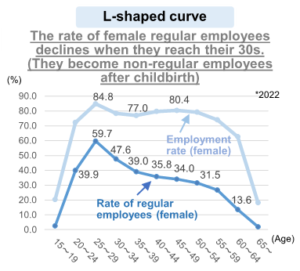Overview of The Basic Policy on Gender Equality and Empowerment of Women 2023

On June 5, the Government of Japan held the Council for Gender Equality and announced the so-called “Women’s Version of the Framework for Gender Equality 2023”. And we would like to take this opportunity to share with you over a number of installments the details of this framework.
The outline of the “Women’s Policy 2023” is as follows.
For full details, please click here.
Following the outline, each item is explained as follows.
- Promotion of efforts to realize a virtuous cycle between women’s activities and economic growth
(i) Top market listed companies aim to have one female board member by 2025 and the ratio of female board members to total board members to be 30% or more by 2030. An action plan will be formulated to achieve this goal.
Within this current year 2023 , establish a performance target for the ratio of female board members for 2025.
(ii) Aim to increase the ratio of female entrepreneurs in the J-Startup program, which is intensively supported by the government and private sector, to 20%.
- Strengthen efforts to increase women’s income and economic independence
(i) Promote leave during child-rearing years and flexible work styles.
- Correcting the practice of long working hours, accelerating efforts to support work-life balance using investor evaluation, and promoting the spread of “diverse regular employee” systems
- Promote the introduction of “interval” (a fixed period of rest time required from the completion of work the previous day to the start of work on that day) systems
- Fundamentally strengthen measures in terms of both systems and benefits in order to realize a society in which male childcare leave is standard
- Eliminate issues surrounding career awareness based on women’s perspectives.
-
- Extension of social insurance coverage to workers with shorter working hours
- Minimum wage increase
- Avoidance of reversal phenomenon barrier currently in place due to the tax implications of earning more than 1.06 million yen – to be implemented by the end of this year
- Consideration of expanding the disclosure of the wage gap between men and women to employers of 101 people or more
(ii) Promotion of reskilling, including the development of female human resources with digital skills.
Promote the use of digital skill standards and an IT Passport exam, and implement a plan to develop female human resources with digital skills, as part of efforts to improve the environment for reskilling.
(iii) Promotion of initiatives that meet regional needs – Transfer of jurisdictions to the Cabinet Office, with the aim of submitting the plan to the 2024 ordinary Diet session
Strengthen the functions of local Gender Equality Centers that support women’s activities in accordance with local needs, and establish the National Women’s Education Center (NWEC) as an independent administrative institution.
Reinforcement of backup support for each center by the National Women’s Education Center (NWEC).
Through these efforts, the government aims to resolve the structural issues* that are behind the L-shaped curve (see below).

* Structural issues,
Specifically
Labor practices centering on long working hours.
Uneven bias for women’s unpaid working hours for housework, childcare.
Fixed gender-role consciousness and stereotyped gender-role divisions.
The last part of the policy states that, in order to realize a society in which women can live with dignity and pride, the Government will take various measures such as revising the Law for the Prevention of Spousal Violence, strengthening measures against sexual crimes and sexual violence, and will address measures against harassment, women’s participation in the policy-making process, reflection of the gender perspective, and women’s participation in the fields of peace and security.











